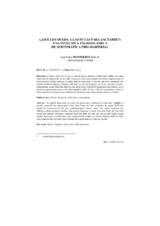¿Qué les queda a las putas para jactarse? Una invectiva paleoislámica de subtemática promartirial
Autor
Monferrer-Sala, J. P.
Editor
Universidad de Cádiz, Servicio de PublicacionesFecha
2006Materia
PoesíaPaganismo
Paleoislam
Automartirio
Poetry
Paganism
Paloe-Islam
Self-martyrdom
METS:
Mostrar el registro METSPREMIS:
Mostrar el registro PREMISMetadatos
Mostrar el registro completo del ítemResumen
El marco ğāhilī en el que se sitúa la pieza, atribuida a Hind bint U h, sirve para
representar la depravación de los Banū Umayyah, como representantes del mundo pagano al que el
nuevo modelo político-religioso, el islam, trata de dejar atrás. La autora, para ello, contrapone dos
modelos político-religiosos distintos utilizando un preciso lenguaje con el que arremete sexual y
culturalmente contra Hind bint Rab `ah, que actúa como símbolo de paganismo anti-islámico cuyos
máximos representantes caen en la mítica batalla de Badr. Frente a ello, los musulmanes caídos en
U ud simbolizan la entrega auto-martirial del musulmán como representante del nuevo modelo. The djāhilī framework in which the poetic piece attributed to Hind bint Uth th h is
located, represents the depravation of the Banū Umayyah, who symbolize the pagan world that
should be transcended by the new political-religious model, Islam. The author confronts two
different political-religious models using precise language to attack Hind bint Rabī `ah from both
sexual and cultural viewpoints. Opposite Hind bint Rabī `ah, who acts like an anti-Islamic pagan
symbol, the leaders of which died in the mythical battle of Badr, we find the Muslims killed in U ud
who symbolize the self-martyrdom offering like representatives of the new model.

